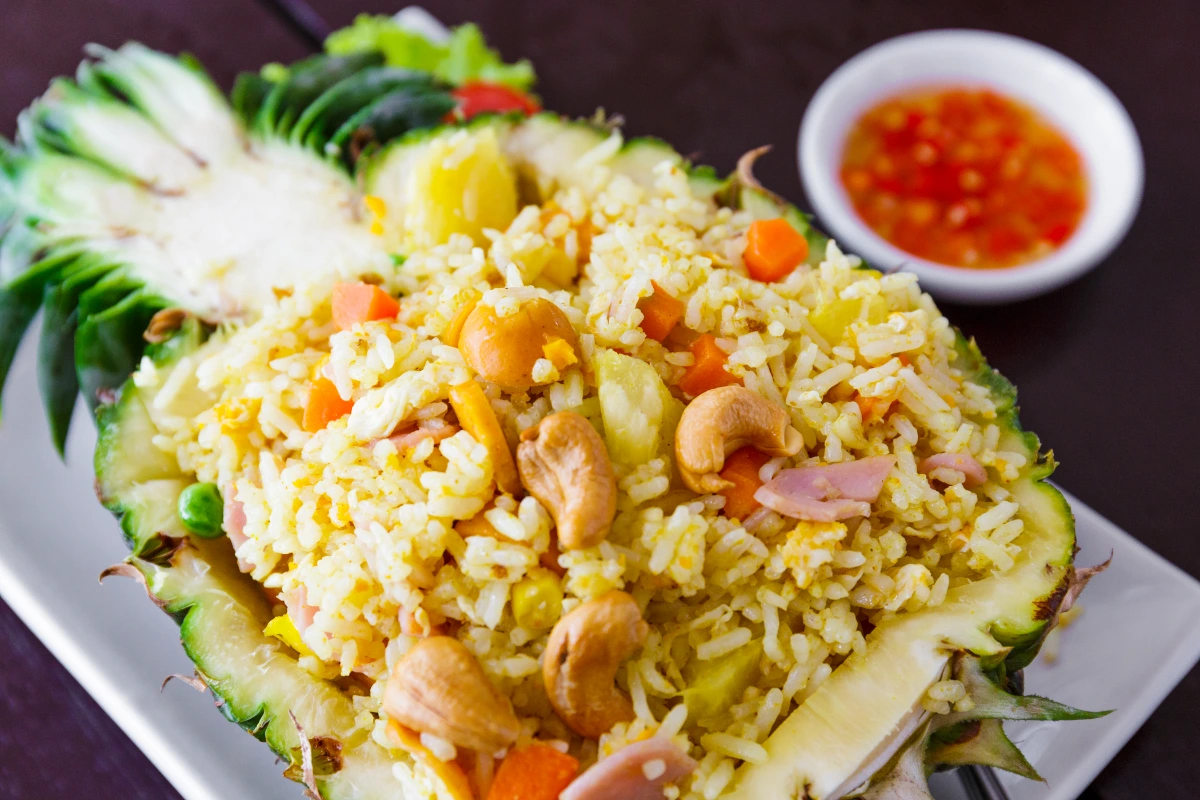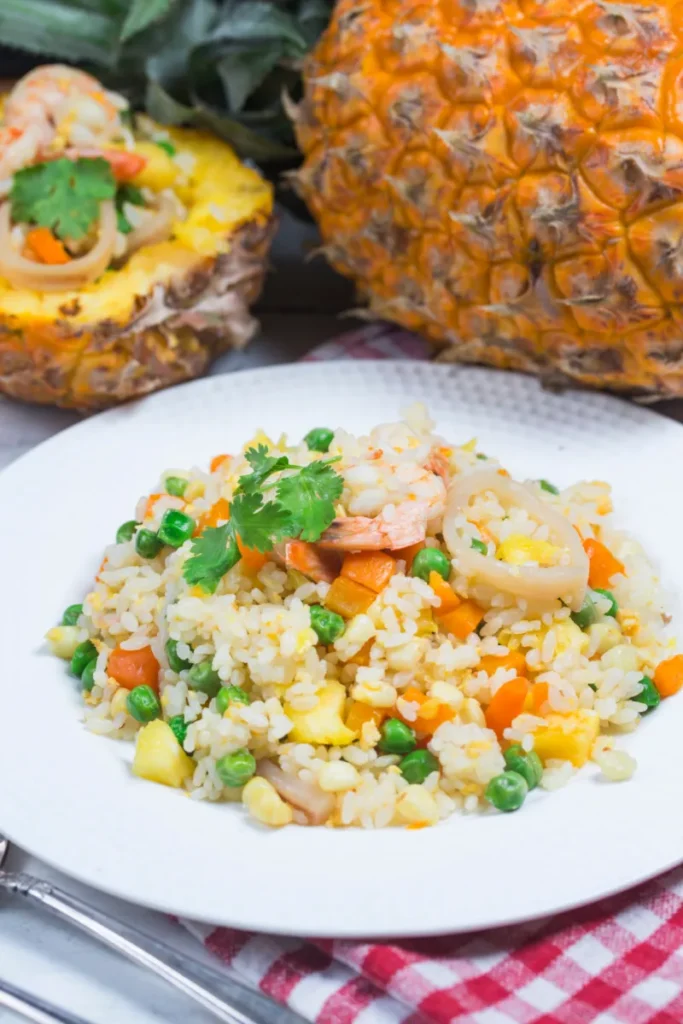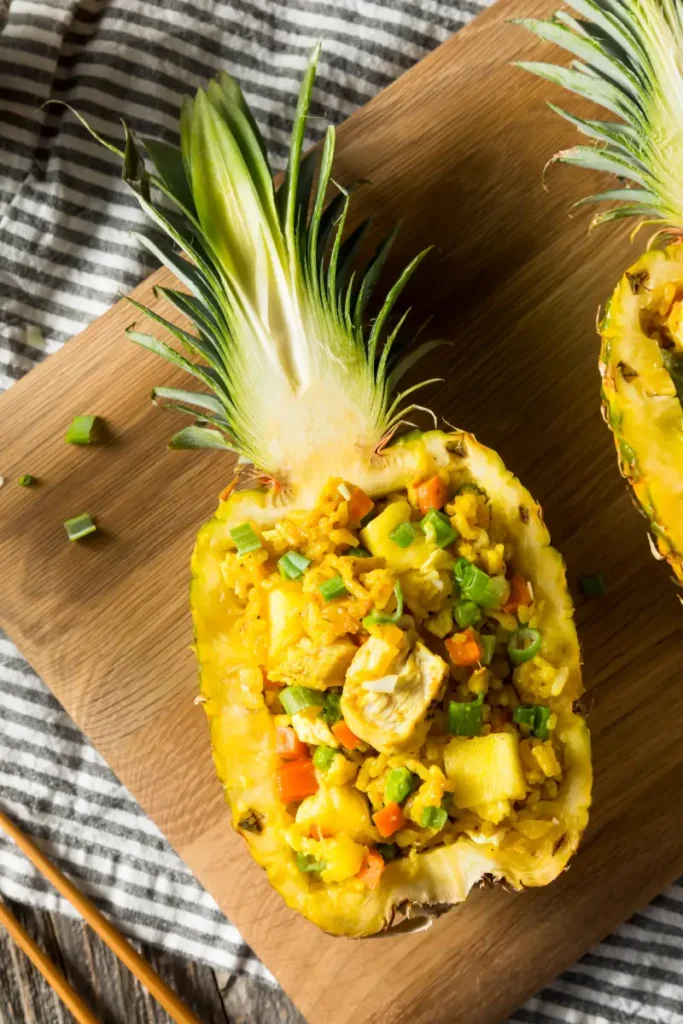The vibrant blend of sweet, savory, and tangy flavors in pineapple fried rice is an experience that ignites the senses. Whether you’re a seasoned cook or just starting out, this guide provides the knowledge and skills to create this beloved dish in your own kitchen.
Get ready to embark on a culinary adventure! We’ll explore the origins and appeal of pineapple fried rice, and guide you through the process of mastering its creation at home. Prepare to be captivated by the flavors and crave more!
Introduction & Basics
What is Pineapple Fried Rice?
Imagine fluffy rice, bursting with the sweetness of pineapple, the savory notes of soy sauce, and a delightful crunch from colorful vegetables. That, my friends, is the essence of pineapple fried rice! This popular dish has roots in various Asian cuisines, particularly Thai and Chinese, where it’s cherished for its balanced flavors and versatility. While variations abound, the core ingredients typically include rice, pineapple, vegetables, protein, and a medley of seasonings.
Why Pineapple Fried Rice is a Popular Dish
But what makes pineapple fried rice such a beloved dish? Well, for starters, it’s a symphony of tastes and textures. The sweetness of pineapple beautifully complements the savory elements, creating a harmonious balance that tantalizes the palate. The contrasting textures of tender rice, juicy pineapple, and crisp vegetables add another layer of enjoyment. And let’s not forget the visual appeal – the vibrant colors make it a feast for the eyes as well! Moreover, pineapple fried rice is incredibly versatile. It can be enjoyed as a satisfying main course or a delightful side dish, making it perfect for any occasion.
Making Pineapple Fried Rice at Home
Alright, it’s time to roll up our sleeves and get cooking! Making pineapple fried rice at home is easier than you might think, and the reward is a delicious, customizable meal that’s sure to impress.
Essential Ingredients
Before we dive into the cooking process, let’s gather our ingredients:
- Rice: The foundation of any good fried rice is, of course, the rice itself. Opt for long-grain varieties like Jasmine or Basmati, known for their fluffy texture and ability to absorb flavors. Cook the rice in advance and let it cool completely – cold rice ensures that your fried rice won’t turn out mushy.
- Pineapple: Now for the star of the show! Fresh pineapple adds a vibrant sweetness and juiciness, while canned pineapple offers convenience. If using fresh, make sure it’s ripe and cut into bite-sized pieces.
- Vegetables and Protein: This is where you can get creative! Popular choices include peas, carrots, bell peppers, onions, and bean sprouts. For protein, consider chicken, shrimp, tofu, or even eggs. Feel free to mix and match according to your preferences.
- Aromatics and Seasonings: Garlic and ginger are essential for adding depth of flavor. Soy sauce, oyster sauce, and fish sauce contribute savory notes, while a touch of sugar balances the sweetness. Don’t forget a pinch of salt and pepper to enhance the overall taste.
Step-by-Step Cooking Guide
- Prep Work: Get everything ready before you fire up the stove. Cook your rice, chop your veggies, and marinate your protein if needed. Having all your ingredients prepped ensures a smooth and efficient cooking process.
- Stir-frying: Heat a wok or large skillet over high heat and add oil with a high smoke point, such as peanut or vegetable oil. Once the oil is shimmering, add the aromatics (garlic and ginger) and stir-fry until fragrant. Next, add your protein and cook until browned.
- Bringing it Together: Now, toss in your vegetables and continue stir-frying until they’re tender-crisp. It’s time for the rice! Add it to the pan and stir-fry until heated through, ensuring every grain is coated with the delicious flavors. Finally, incorporate the pineapple chunks and seasonings, adjusting to taste.
- Finishing Touches: Garnish your pineapple fried rice with chopped scallions, cilantro, or a sprinkle of sesame seeds for added visual appeal and a touch of freshness. Serve hot and enjoy the fruits (and veggies) of your labor!
Tips for Perfect Pineapple Fried Rice
- Use Cold, Cooked Rice: As mentioned earlier, cold rice is key to preventing mushy fried rice. Spread it out on a baking sheet after cooking to help it cool down faster.
- High Heat and Constant Stirring: The secret to achieving that desirable smoky flavor and preventing sticking is high heat and continuous stirring. Keep things moving in the pan!
- Balance is Key: Taste as you go and adjust seasonings accordingly. You want a harmonious balance between sweet, salty, and savory.
- Get Creative: Don’t be afraid to experiment with different vegetables, proteins, and even spices to create your own signature pineapple fried rice masterpiece. The possibilities are endless!
Just like that, you’ve learned the basics of crafting a delicious pineapple fried rice at home. But wait, there’s more! In the next section, we’ll explore exciting variations and customizations to take your fried rice game to the next level.
Variations and Customizations
The beauty of pineapple fried rice lies in its versatility. Once you’ve mastered the basic recipe, a world of exciting variations and customizations awaits! Let’s explore some popular options to inspire your culinary creativity.
Regional Variations
- Thai Pineapple Fried Rice: This vibrant version bursts with the quintessential flavors of Thai cuisine. Fish sauce and lime juice add a salty-sour tang, while Thai chilies bring a touch of heat. Cashews provide a satisfying crunch, and a sprinkle of fresh herbs like cilantro and Thai basil elevates the aroma.
- Chinese Pineapple Fried Rice: In Chinese cuisine, pineapple fried rice often features a savory-sweet profile with a focus on soy sauce and oyster sauce for umami depth. Char siu pork or succulent shrimp are common protein choices, while the addition of scrambled eggs adds richness and texture.
- Other Variations: From Vietnamese pineapple fried rice with its fragrant lemongrass and mint to Indonesian nasi goreng nanas with its fiery sambal, each region offers its unique twist. Explore and discover the diverse flavors of pineapple fried rice from around the world.
Dietary Adaptations
- Vegetarian/Vegan: Plant-based eaters can rejoice! Simply swap out the meat for protein-packed alternatives like tofu, tempeh, or even jackfruit. To enhance the umami flavor, consider using vegetarian oyster sauce or mushroom-based seasonings.
- Gluten-Free: For those with gluten sensitivities, ensure you use gluten-free soy sauce or tamari. Double-check the labels of other ingredients like oyster sauce to ensure they meet your dietary needs.
- Other Dietary Needs: Pineapple fried rice can be easily adapted to various dietary restrictions. For instance, individuals with nut allergies can omit cashews or use sunflower seeds as a substitute. The key is to be mindful of the ingredients and make substitutions accordingly.
Whether you prefer a specific regional style or need to cater to dietary requirements, pineapple fried rice offers endless possibilities. So go ahead, get creative, and personalize this dish to your heart’s content!
Serving and Enjoying Pineapple Fried Rice
You’ve put your heart (and spatula) into creating a delicious pineapple fried rice masterpiece – now it’s time to savor the fruits of your labor!
Serving Suggestions
- Main Dish or Sidekick: Pineapple fried rice is incredibly versatile and can take center stage as a satisfying main course or play a supporting role as a delightful side dish. Pair it with grilled chicken, fish, or tofu for a complete meal, or serve it alongside other Asian-inspired dishes for a flavorful feast.
- Complementary Dishes: To round out your meal, consider serving pineapple fried rice with a refreshing cucumber salad, a tangy mango salsa, or a side of steamed edamame. These accompaniments provide contrasting flavors and textures, enhancing the overall dining experience.
- Presentation is Key: Don’t underestimate the power of presentation! Elevate your pineapple fried rice by serving it in a hollowed-out pineapple half for a tropical touch. Garnish with fresh herbs, a sprinkle of sesame seeds, or a lime wedge for an extra burst of flavor and visual appeal.
Storage and Reheating
If you happen to have leftovers (which is quite possible given how delicious pineapple fried rice is!), proper storage and reheating methods are crucial for maintaining its quality.
- Storage: Allow the pineapple fried rice to cool completely before transferring it to an airtight container. Store it in the refrigerator for up to 3-4 days.
- Reheating: The best way to reheat pineapple fried rice is on the stovetop. Heat a little oil in a pan or wok, add the rice, and stir-fry gently until heated through. This method helps retain the texture and prevents the rice from becoming soggy.
With these tips in mind, you’re ready to enjoy your pineapple fried rice to the fullest! Whether it’s a weeknight dinner or a special occasion, this dish is sure to impress your taste buds and leave you wanting more.
FAQs About Pineapple Fried Rice
Pineapple fried rice often sparks curiosity and questions. Let’s address some of the most frequently asked questions to clear up any uncertainties and enhance your understanding of this beloved dish.
What is pineapple fried rice made of?
Pineapple fried rice typically consists of cooked rice, pineapple chunks (fresh or canned), vegetables (such as peas, carrots, and bell peppers), protein (like chicken, shrimp, or tofu), and a blend of seasonings including soy sauce, oyster sauce, and garlic.
What is the secret ingredient to restaurant fried rice?
One of the key “secrets” to restaurant-style fried rice is using a wok and high heat for stir-frying. This method results in a smoky flavor and slightly charred rice that’s difficult to replicate at home without the proper equipment. Additionally, restaurants often use a combination of oils and sauces to achieve their signature flavor profiles.
What gives Chinese fried rice its flavor?
The distinct flavor of Chinese fried rice comes from a combination of factors:
- Seasonings: Soy sauce, oyster sauce, and sesame oil are commonly used to add umami depth and savory notes.
- Aromatics: Garlic, ginger, and scallions contribute to the overall flavor profile.
- Wok Hei: The “breath of the wok” refers to the smoky flavor imparted by high-heat cooking in a wok.
- Ingredient Balance: The balance between the savory seasonings, vegetables, protein, and rice creates a harmonious and flavorful dish.
What type of rice is best for pineapple fried rice?
Long-grain rice varieties like Jasmine or Basmati are ideal for pineapple fried rice. Their fluffy texture and ability to absorb flavors without becoming mushy make them the perfect choice. Avoid using short-grain rice, as it tends to be stickier and may result in denser fried rice.
Can I use fresh pineapple instead of canned?
Absolutely! Fresh pineapple adds a vibrant sweetness and juiciness that canned pineapple can’t quite replicate. However, canned pineapple offers convenience and can be a good option if fresh pineapple isn’t readily available. If using fresh pineapple, ensure it’s ripe and cut it into bite-sized pieces.
Is pineapple fried rice healthy?
Pineapple fried rice can be a healthy dish, depending on the ingredients and preparation methods. The rice provides carbohydrates for energy, while the pineapple contributes vitamins, minerals, and antioxidants. Adding plenty of vegetables boosts the nutritional value, and opting for lean protein sources like chicken, shrimp, or tofu keeps it light. Be mindful of the amount of oil and sodium used during cooking, and consider using brown rice for added fiber.
How do I prevent my fried rice from getting mushy?
The key to preventing mushy fried rice is using cold, cooked rice. Spreading the cooked rice on a baking sheet to cool down quickly helps achieve the desired texture. Additionally, high heat and constant stirring during the stir-frying process prevent the rice from sticking and becoming soggy.
Additional Tips:
For a deeper dive into the fascinating history of fried rice and its cultural significance, check out The Spruce Eats’ insightful article on the topic! If you’re curious about the health benefits of pineapple, Healthline offers a comprehensive overview of its nutritional value and potential health-promoting properties.
By understanding these FAQs and incorporating the helpful tips, you’re well on your way to mastering the art of pineapple fried rice. Remember, the most important ingredient is your creativity, so have fun and enjoy the process!
Conclusion: A Culinary Adventure Awaits
From its humble origins to its global popularity, pineapple fried rice has come a long way. This versatile dish has captured the hearts (and stomachs) of countless food enthusiasts with its vibrant flavors, contrasting textures, and endless possibilities for customization. Whether you’re a seasoned chef or a kitchen novice, pineapple fried rice offers a culinary adventure that’s both exciting and rewarding. So, gather your ingredients, fire up the stove, and embark on a flavor-filled journey that will tantalize your taste buds and leave you craving more. Remember, the key is to have fun, experiment, and make this dish your own. After all, the best pineapple fried rice is the one that brings joy to your table and creates lasting memories around shared meals. Now, go forth and conquer the world of pineapple fried rice!
Additional Tasty Recipes:
- Coconut Flan: Dive into the creamy delight of our Coconut Flan, a perfect blend of tropical coconut and silky caramel. It’s an easy, irresistible treat that’s bound to impress. Discover how to make it.
- Mexican Wedding Cakes: Experience the joy of baking our Mexican Wedding Cakes, buttery cookies with a nutty twist, coated in powdered sugar. They’re simple, delightful, and perfect for any occasion.




1 thought on “Pineapple Fried Rice: Your Guide to Tropical Flavor at Home”